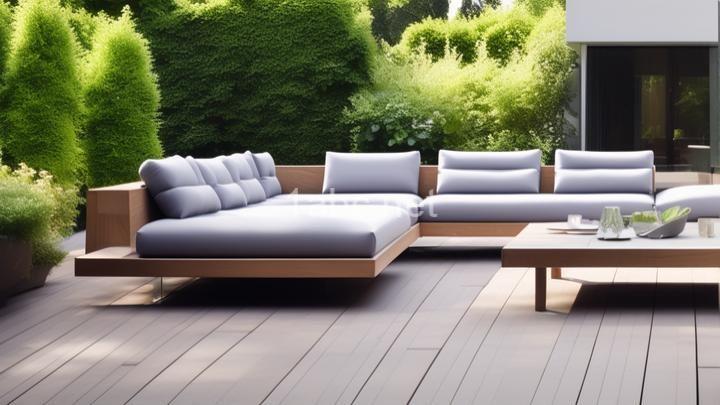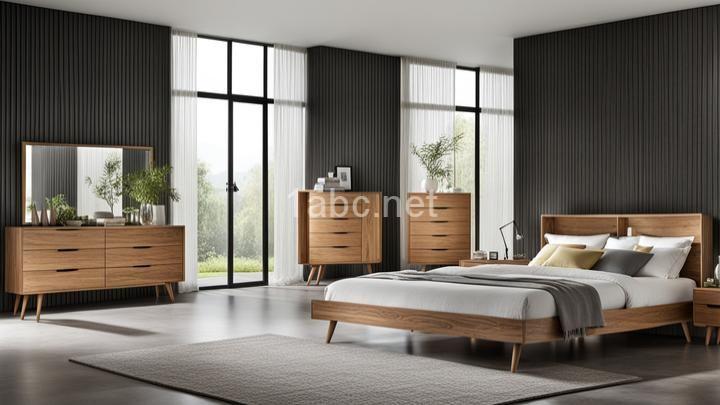The Ultimate Guide to Choosing Durable Materials for Your Home & Garden Furniture

Introduction:
Welcome readers to the ultimate guide on selecting durable materials for your home and garden furniture. We understand that choosing the right materials for your furniture can be overwhelming, but fear not! We are here to provide you with all the information you need to make informed decisions. Whether you're furnishing your living room, dining area, or outdoor space, we've got you covered. So, grab a cup of coffee, get cozy, and let's dive into the world of durable furniture materials.
I. Importance of Durability in Home & Garden Furniture
When it comes to investing in furniture, durability should be at the top of your priority list. Furniture is meant to last, and choosing materials that can withstand daily wear and tear is essential. Imagine having to replace your sofa every few years because it's falling apart or your outdoor dining set disintegrating after one summer season. Not only is this frustrating, but it also adds unnecessary expenses.
Investing in durable materials may require a higher upfront cost, but it will save you money in the long run. By choosing materials that are built to last, you won't have to worry about frequent repairs or replacements. So, let's explore the factors to consider when selecting durable materials for your furniture.
II. Factors to Consider When Choosing Durable Materials
A. Weather Resistance
When it comes to outdoor furniture, weather resistance is a crucial factor to consider. Your furniture will be exposed to various weather conditions like rain, sunlight, and fluctuating temperatures. Therefore, it's essential to choose materials that can withstand these elements without deteriorating.
Teak is a popular choice for outdoor furniture due to its natural resistance to moisture and insects. It also develops a beautiful patina over time. Aluminum and stainless steel are also excellent options as they are rust-resistant and can withstand harsh weather conditions.
B. Maintenance Requirements
Different materials require different levels of maintenance. Some may require regular cleaning, polishing, or oiling, while others may be more low-maintenance. It's important to consider your lifestyle and the amount of time you're willing to put into maintaining your furniture.
For example, hardwoods like oak and maple require periodic oiling to maintain their beauty and prevent drying out. On the other hand, materials like aluminum and stainless steel only require occasional cleaning with mild soap and water.
C. Strength and Sturdiness
The strength and sturdiness of furniture materials are essential, especially for pieces that will be frequently used or bear weight. You want furniture that can withstand the test of time and daily use without wobbling or breaking.
Hardwoods like oak and maple are known for their durability and strength. They can handle heavy usage and resist dents and scratches. Metal frames, such as those made from steel, are also renowned for their sturdiness and can provide excellent support.
D. Longevity and Resistance to Wear
Furniture materials should be able to withstand wear and tear without losing their aesthetic appeal. Nobody wants furniture that starts looking worn out and shabby after a short period.
High-quality synthetic rattan is an excellent choice for outdoor furniture as it is resistant to fading, cracking, and peeling. Vinyl-coated fabrics are also durable and can withstand heavy use without losing their color or texture.
III. Popular Durable Materials for Home & Garden Furniture
Now that we've discussed the factors to consider let's explore some popular durable materials for home and garden furniture.
A. Wood
- Hardwoods: Teak and oak are popular choices for their natural beauty and durability. Teak is highly resistant to moisture, rot, and insects, making it ideal for outdoor furniture. Oak, on the other hand, is known for its strength and longevity.
- Pressure-treated wood: This type of wood is treated with chemicals to increase its resistance to rot and decay. It is commonly used for outdoor furniture.
B. Metal
- Aluminum: Lightweight, rust-resistant, and easy to maintain, aluminum is a popular choice for outdoor furniture. It can be easily molded into various shapes and is available in different finishes.
- Stainless steel: Known for its strength and corrosion resistance, stainless steel is a durable choice for both indoor and outdoor furniture. It adds a sleek and modern touch to any space.
C. Synthetic Rattan/Wicker
Synthetic rattan or wicker is a versatile and durable material that mimics the natural look of traditional rattan. It is resistant to fading, cracking, and peeling, making it perfect for outdoor furniture. Additionally, it requires minimal maintenance.
D. Plastic/PVC
Plastic or PVC furniture is lightweight, affordable, and resistant to weather conditions. It is easy to clean and can be a budget-friendly option for outdoor furniture. However, it may not offer the same level of aesthetic appeal as other materials.
IV. Matching Durability with Style and Design Preferences
While durability is crucial, it's also important to consider your personal style and design preferences. Your furniture should not only be durable but also complement your overall aesthetic.
For a rustic or traditional look, hardwoods like teak and oak are excellent choices. If you prefer a more modern and sleek style, metals like aluminum and stainless steel can add a contemporary touch. Synthetic rattan/wicker can provide a natural and cozy vibe, while plastic/PVC furniture can be a fun and vibrant choice for a casual outdoor space. By considering your style preferences, you can find durable materials that align with your design vision.
V. Budget Considerations
Budget plays a significant role in choosing furniture materials. While it's important to invest in durable materials, it doesn't mean you have to break the bank. There are options available for different price ranges without compromising on quality and durability.
For those on a tighter budget, plastic/PVC furniture can be a cost-effective choice for outdoor settings. Pressure-treated wood is also a more affordable alternative to hardwoods like teak. If you have a larger budget, hardwoods and metals like aluminum and stainless steel offer durability and elegance.
Conclusion:
Congratulations! You've made it through the ultimate guide to choosing durable materials for your home and garden furniture. We hope this comprehensive guide has provided you with the knowledge and confidence to make informed decisions. Remember, durability should always be a top consideration when selecting furniture materials, but don't forget to align it with your style preferences and budget.
Investing in durable materials will not only save you money in the long run but also ensure that your furniture stands the test of time. So go ahead, create a beautiful and long-lasting space that you can enjoy for years to come. Happy decorating!
FREQUENTLY ASKED QUESTIONS
What is the purpose of this guide?
The purpose of this guide is to help you understand and navigate the topic at hand. It aims to provide you with valuable information, tips, and techniques that can assist you in achieving your goals. Whether you are a beginner or an experienced individual, this guide is designed to cater to your needs and help you make informed decisions. So, sit back, relax, and let's embark on this journey together!
Why is it important to choose durable materials for furniture?
Choosing durable materials for furniture is important for several reasons. First and foremost, durability ensures that the furniture will last longer, saving you money in the long run. Nobody wants to invest in furniture that will quickly wear out or break down, forcing them to replace it sooner than expected.Additionally, durable materials are more resistant to everyday wear and tear, such as spills, stains, and scratches. This is especially crucial if you have kids or pets who can be a little rough on furniture. By opting for durable materials, you can enjoy peace of mind knowing that your furniture can withstand the inevitable accidents and mishaps that come with daily life.
Not only does durability affect the lifespan and appearance of furniture, but it also contributes to its overall functionality. Sturdy and long-lasting materials provide a stable and reliable structure, ensuring that your furniture remains comfortable and supportive for years to come.
Furthermore, choosing durable materials is also an environmentally conscious decision. By investing in furniture that is built to last, you avoid contributing to the cycle of disposable furniture. This reduces waste and the need for constant production, ultimately benefiting the environment.
In conclusion, selecting furniture made from durable materials is essential because it saves you money, withstands wear and tear, enhances functionality, and promotes sustainability. So, when making your next furniture purchase, consider the durability factor to ensure you are making a wise and long-lasting investment.
What are some common durable materials for furniture?
There are several common durable materials used for furniture that can withstand everyday wear and tear. Some of these materials include:
-
Solid wood: Furniture made from solid wood, such as oak, maple, or mahogany, is known for its strength and durability. It can withstand heavy use and last for many years with proper care.
-
Plywood: Plywood is a composite material made from layers of wood veneer. It is known for its strength and resistance to warping or cracking, making it a popular choice for furniture construction.
-
Metal: Furniture made from metals like steel or aluminum is highly durable and can withstand heavy use. Metal frames are often used for chairs, tables, and outdoor furniture.
-
Leather: Leather upholstery is not only stylish but also durable. It is resistant to stains, spills, and scratches, making it a great choice for furniture that gets a lot of use.
-
Microfiber: Microfiber is a synthetic fabric known for its durability and stain resistance. It is a popular choice for upholstered furniture, as it is easy to clean and maintain.
-
Wicker: Wicker furniture is made from woven plant fibers, such as rattan or bamboo. It is lightweight, durable, and often used for outdoor furniture.
-
Glass: While not typically used for entire furniture pieces, glass is often incorporated into tabletops or shelving. Tempered glass, in particular, is highly durable and resistant to breakage.
These are just a few examples of common durable materials used in furniture construction. It's important to consider the specific needs and style preferences when choosing furniture materials.
How can I determine the durability of a material?
Determining the durability of a material involves assessing its ability to withstand wear, tear, and other adverse conditions over time. Here are a few methods you can use to evaluate material durability:
-
Physical Testing: Conducting physical tests is a common approach to determine material durability. This may involve subjecting the material to different stressors such as impact, compression, or abrasion. By measuring the material's response to these tests, you can gain insights into its strength, resistance, and potential for long-term use.
-
Accelerated Aging: Another method is to simulate the effects of aging on the material. This can be done through accelerated aging tests, where the material is exposed to extreme conditions like heat, humidity, or UV radiation. By examining how the material behaves under such conditions, you can predict its durability over an extended period.
-
Real-Life Conditions: Assessing material durability in real-life conditions is crucial. This involves observing how the material performs in its intended environment, considering factors like temperature variations, moisture levels, and exposure to chemicals. By monitoring any signs of degradation, such as cracking, discoloration, or loss of strength, you can gauge the material's ability to withstand long-term use.
-
Previous Experience and Data: Drawing from previous experience or existing data on similar materials can also provide valuable insights into durability. Manufacturers often test and document the performance of their materials, which can serve as a useful reference point. Additionally, seeking feedback from users who have used the material in a similar context can provide valuable insights into its durability.
Remember, the durability of a material is influenced by various factors, including its composition, design, and intended use. It is important to consider these factors holistically when evaluating material durability.

